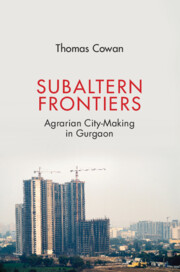4 - The Bureaucrat and the Survey
Published online by Cambridge University Press: 12 August 2022
Summary
DRAFTING THE CITY
‘That’s the problem with these maps: this one was in such bad condition we couldn't read it.’ Squinting to read the scrawled handwriting of the field book, Ajay sifted through photographs, hand-drawn plot sketches, land record copies and a cloth cadastral map depicting the parcel of land our jeep was parked on in the western periphery of Gurgaon. With a laptop precariously balanced on his knees, we were attempting to draft the contours of property in the land on the AutoCAD software in preparation for the day's boundary demarcation. Pushing his fingers across his temples, Ajay lamented the poor condition of the records that Virinder, the kanungo (a senior field-bureaucrat within the Haryana Revenue Department), had brought along: ‘These records are unclear, this road could be anywhere … they had a new one made, of course we have the mussavi [original cadastral map] and the GPS survey image but we have to be certain with these things.’ Ajay explained that our attempts to survey and correct a disputed boundary between the two parties’ property was likely to be difficult. Not only are there frequent inconsistencies and points of ambivalence within the documents we were sifting through, but also the land had already been subjected to two cadastral surveys over the previous twelve months. With each survey, each conducted using different technologies and methods, new certified maps came into circulation that would come to obscure the veracity of the boundary. As we attempted to map out a copy of the record onto the software, Ajay pointed out some of these inconsistencies from the jeep window: ‘Look here on the ground the [grid] is not accurate, this here road is not straight like this, it is coming at an angle, see? These plots are not square – there will always be difference between the maps, the survey [image] and the land itself.’ On top of all of this, not all land claims are recorded in the map. Post-colonial land gridding and consolidation screened out messy non-geometric property from the revenue maps, leaving thousands of property shares hidden from state view. To find these unmapped shares we search through the textual data of the jamabandi (landholding register) and field book (original settlement notes) and a series of smaller hand-drawn sketches of land parcels that are yet to make it into the cadastral map.
- Type
- Chapter
- Information
- Subaltern FrontiersAgrarian City-Making in Gurgaon, pp. 178 - 214Publisher: Cambridge University PressPrint publication year: 2023



